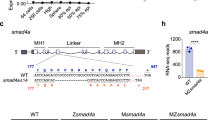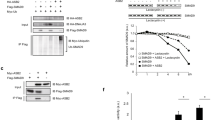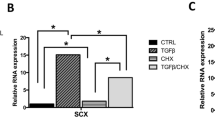Abstract
Smad proteins are intracellular mediators of signalling initiated by Tgf-βsuperfamily ligands (Tgf-βs, activins and bone morphogenetic proteins (Bmps)). Smads 1, 2, 3, 5 and 8 are activated upon phosphorylation by specific type I receptors, and associate with the common partner Smad4 to trigger transcriptional responses1. The inhibitory Smads (6 and 7) are transcriptionally induced in cultured cells treated with Tgf-β superfamily ligands, and downregulate signalling in in vitro assays2,3,4,5,6,7. Gene disruption in mice has begun to reveal specific developmental and physiological functions of the signal-transducing Smads. Here we explore the role of an inhibitory Smad in vivo by targeted mutation of Madh6 (which encodes the Smad6 protein). Targeted insertion of a LacZ reporter demonstrated that Smad6 expression is largely restricted to the heart and blood vessels, and that Madh6 mutants have multiple cardiovascular abnormalities. Hyperplasia of the cardiac valves and outflow tract septation defects indicate a function for Smad6 in the regulation of endocardial cushion transformation. The role of Smad6 in the homeostasis of the adult cardiovascular system is indicated by the development of aortic ossification and elevated blood pressure in viable mutants. These defects highlight the importance of Smad6 in the tissue-specific modulation of Tgf-β superfamily signalling pathways in vivo.
This is a preview of subscription content, access via your institution
Access options
Subscribe to this journal
Receive 12 print issues and online access
$209.00 per year
only $17.42 per issue
Buy this article
- Purchase on Springer Link
- Instant access to full article PDF
Prices may be subject to local taxes which are calculated during checkout




Similar content being viewed by others
References
Massague, J. TGF-β signal transduction. Annu. Rev. Biochem. 67, 753–791 (1998).
Afrakhte, M. et al. Induction of inhibitory Smad6 and Smad7 mRNA by TGF-β family members. Biochem. Biophys. Res. Commun. 249, 505–511 (1998).
Hata, A., Lagna, G., Massague, J. & Hemmati-Brivanlou, A. Smad6 inhibits BMP/Smad1 signaling by specifically competing with the Smad4 tumor suppressor. Genes Dev. 12, 186–197 (1998).
Imamura, T. et al. Smad6 inhibits signalling by the TGF-β superfamily. Nature 389, 622–626 (1997).
Ishisaki, A. et al. Differential inhibition of Smad6 and Smad7 on bone morphogenetic protein- and activin-mediated growth arrest and apoptosis in B cells. J. Biol. Chem. 274, 13637–13642 (1999).
Takase, M. et al. Induction of Smad6 mRNA by bone morphogenetic proteins. Biochem. Biophys. Res. Commun. 244, 26–29 (1998).
Topper, J.N. et al. Vascular MADs: two novel MAD-related genes selectively inducible by flow in human vascular endothelium. Proc. Natl Acad. Sci. USA 94, 9314–9319 (1997).
Cohen, R.A., Zitnay, K.M., Weisbrod, R.M. & Tesfamariam, B. Influence of the endothelium on tone and the response of isolated pig coronary artery to norepinephrine. J. Pharmacol. Exp. Ther. 244, 550–555 (1988).
Huang, J.X., Potts, J.D., Vincent, E.B., Weeks, D.L. & Runyan, R.B. Mechanisms of cell transformation in the embryonic heart. Ann. NY Acad. Sci. 752, 317–330 (1995).
Reddi, A.H. Bone and cartilage differentiation. Curr. Opin. Genet. Dev. 4, 737–744 (1994).
Bostrom, K., Watson, K.E., Stanford, W.P. & Demer, L.L. Atherosclerotic calcification: relation to developmental osteogenesis. Am. J. Cardiol. 75, 88B–91B (1995).
Brown, C.B., Boyer, A.S., Runyan, R.B. & Barnett, J.V. Requirement of type III TGF-β receptor for endocardial cell transformation in the heart. Science 283, 2080–2082 (1999).
Marchuk, D.A. Genetic abnormalities in hereditary hemorrhagic telangiectasia. Curr. Opin. Hematol. 5, 332–338 (1998).
Moore, C.S., Mjaatvedt, C.H. & Gearhart, J.D. Expression and function of activin β A during mouse cardiac cushion tissue formation. Dev. Dyn. 212, 548–562 (1998).
Perrella, M.A., Jain, M.K. & Lee, M.E. Role of TGF-β in vascular development and vascular reactivity. Miner. Electrolyte Metab. 24, 136–143 (1998).
Dudley, A.T. & Robertson, E.J. Overlapping expression domains of bone morphogenetic protein family members potentially account for limited tissue defects in BMP7 deficient embryos. Dev. Dyn. 208, 349–362 (1997).
Millan, F.A., Denhez, F., Kondaiah, P. & Akhurst, R.J. Embryonic gene expression patterns of TGF β 1, β 2 and β 3 suggest different developmental functions in vivo. Development 111, 131–143 (1991).
Mercer, E.H., Hoyle, G.W., Kapur, R.P., Brinster, R.L. & Palmiter, R.D. The dopamine β-hydroxylase gene promoter directs expression of E. coli lacZ to sympathetic and other neurons in adult transgenic mice. Neuron 7, 703–716 (1991).
McBurney, M.W. et al. The mouse Pgk-1 gene promoter contains an upstream activator sequence. Nucleic Acids Res. 19, 5755–5761 (1991).
Bradley, A. in Teratocarcinomas and Embryonic Stem Cells: A Practical Approach (ed. Robertson, E.J.) (IRL, Oxford, 1987).
Bonnerot, C.N. & Nicolas, J.-F in Methods in Enzymology 225: Guide to Techniques in Mouse Development (eds Wassarman, P.M. & DePamphilis, M.L.) 451–472 (Academic, San Diego, 1993).
Lalli, J., Harrer, J., Luo, W., Kranias, E.G. & Paul, R.J. Targeted ablation of the phospholamban gene is associated with a marked decrease in sensitivity in aortic smooth muscle. Circ. Res. 80, 506–513 (1997).
Acknowledgements
We thank M. Nomura and E. Li for help with embryo analysis; V. Kadambi, G. Garcia-Cardeña and R. Breitbart for helpful discussions; Q. Fang and R. Riley for animal care; M. Nieman, R.L. Sutliff and C. Weber for technical contributions; and the help and advice of all our colleagues. This work was supported by Eli Lilly.
Author information
Authors and Affiliations
Corresponding author
Rights and permissions
About this article
Cite this article
Galvin, K., Donovan, M., Lynch, C. et al. A role for Smad6 in development and homeostasis of the cardiovascular system. Nat Genet 24, 171–174 (2000). https://doi.org/10.1038/72835
Received:
Accepted:
Issue Date:
DOI: https://doi.org/10.1038/72835
This article is cited by
-
Genetic Variants within NOGGIN, COL1A1, COL5A1, and IGF2 are Associated with Musculoskeletal Injuries in Elite Male Australian Football League Players: A Preliminary Study
Sports Medicine - Open (2022)
-
Bariatric surgery-induced weight loss and associated genome-wide DNA-methylation alterations in obese individuals
Clinical Epigenetics (2022)
-
Genomic frontiers in congenital heart disease
Nature Reviews Cardiology (2022)
-
SMAD6-deficiency in human genetic disorders
npj Genomic Medicine (2022)
-
The versatility and paradox of BMP signaling in endothelial cell behaviors and blood vessel function
Cellular and Molecular Life Sciences (2022)



